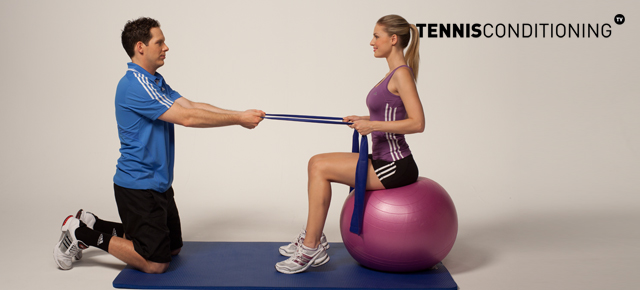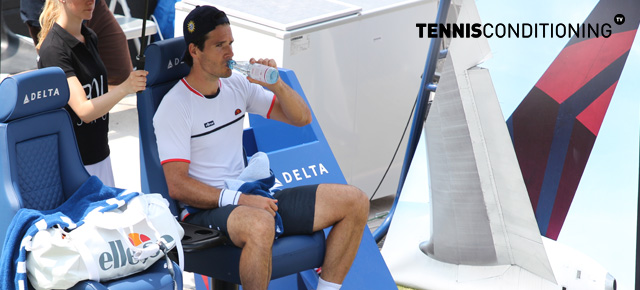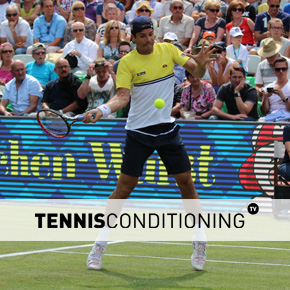Bioenergetics can be defined as the study of biological energy transformation. Get more information on how the body transforms energy from foods.

The 1st law of thermodynamics states that energy is not produced or created but just transferred around.
In other words, the body doesn’t produce any energy but simply transfers the energy derived from foods inside the body to an external environment.
According to Lord Kelvin, the 2nd law of thermodynamics can be expressed as:
“No process is possible in which the sole result is the absorption of heat from a reservoir and its complete conversion into work.”
Meaning when energy is being converted a 100% conversion is not possible because some of energy will be “lost” as heat.
With regards to exercise, the rate and the magnitude of the energy loss depends upon intensity and the environment one is affected by.

For example, with respect to changes in the environment, when one steps into an ice cold bath then the body’s core temperature drops and the body burns a ton of calories because it tries to maintain/increase core body temperature.
On the other hand, during weight lifting exercise (e.g. Power Clean) intensity is high and the magnitude of the energy loss is going to be significant and fatigue sets in.
Biological Energy Transformation via Coupled Reaction

A chemical reaction that “adds” energy to a reactant (an ingredient of the initial reaction) before another reaction can occur is called endergonic reaction (e.g. condensation; anabolic reaction; potential energy).
In other words, during an anabolic reaction (e.g. condensation) the energy is being transformed into potential energy (explained shortly).
On the other hand, a chemical reaction that “releases” energy due to a chemical reaction is termed exergonic reaction (e.g. hydrolysis; catabolic reaction; kinetic energy).
In other words, during a catabolic reaction (e.g. hydrolysis) the energy is being transformed into kinetic energy.

The body derives the required biological energy transformation by converting foods into energy (ATP; adenosine triphosphate) via chemical processes on the cellular level.
More specifically, during energy metabolism, cells use exergonic (energy releasing) reactions to break down food to form ATP via an endergonic (energy adding) reaction, which then can be used to do the work.
This is called a coupled reaction (e.g. Reduction-Oxidation Reaction or RedOx reaction), where energy is released in reaction A so that reaction B can occur.
Therefore, a coupled reaction (Red-Ox reaction) provides ATP, which then can be used to do the work.
Oxidation-Reduction Reaction

Oxidation-Reduction reaction, also called Red-Ox reaction, is just a combination of oxidation and reduction reactions. It is a “partnership” just like hydrolysis and condensation is a partnership.
Oxidation simply means that an electron is removed from an atom or molecule during the reaction. It does not mean that oxygen is used in the reaction.
Instead, the term originated because of the fact that oxygen generally tends to accept electrons and hence acts as an oxidizing agent (something that helps in getting it done).
The oxidizing agent is the atom that accepts the electron during the reduction process. This important property of oxygen (accepting electrons) is used by cells during aerobic energy metabolism to produce usable energy (e.g. Electron Transport Chain) in the mitochondria.
Reduction means that an electron is added to the atom or molecule. The reducing agent is the donor atom that gives away the electron during a reduction.
During Red-Ox reactions, the atom that lost an electron is looking to gain and electron again and the atom that gained an electron is looking to donate it again.
It’s important to point out that oxidation-reduction reactions involve the transfer of hydrogen atoms (which have just 1 electron) instead of free electrons!
There are two coenzymes that are important for hydrogen transfer/transport:
- Nicotinamide Adenine Dinucleotide (NAD): is derived from vitamin B3 (niacin)
- Flavin Adenine Dinucleotide (FAD): is derived from vitamin B2 (riboflavin)
Kinetic Energy vs. Potential Energy

All the energy inside the body is in either one of two states:
- Kinetic Energy (F = m x a; m = mass of the object, a = acceleration/speed; Newton’s 2nd law of motion): form of energy during catabolic reactions, where energy is being released
- Potential Energy (Potential Energy: PE = m x g x h; where, PE = Potential Energy, m = Mass of object, g = Acceleration of Gravity = 9.8 m/s2, h = Height of object): form of energy during anabolic reactions, where energy is being stored; it can also be energy through position.
For example, when glycogen is formed then it’s in a potential energy state but when it is being processed for release then it’s in the kinetic energy state.

One of the other things that can be confusing with respect to potential energy is that it’s not only some sort of energy storage but it also can be energy by position due to gravitational pull.
For example, if you roll a rock on top of a hill and release it then the amount of energy that will develop by the time it’s at the bottom of the hill is significant due to gravitational pull.
All that occurs is conversion of potential energy into kinetic energy (you take the center of mass and multiply it by the speed/velocity/acceleration it moves down the hill and you can measure how much energy was transferred).
During the transfer or conversion from potential energy to kinetic energy, or vice versa, some energy cannot be converted and is “lost” to the environment in the form of heat.

Also, potential energy continues to decline the longer the potential state exists.
For example, the coliseum in Rome at one point in time it was a solid structure and it had potential energy but it’s not the same structure today because the stones and minerals are broken down due to environmental oxidation (hydrogen and oxygen broke the structure down).
Or if you have a battery in your car but you don’t drive it a long time to recharge the battery, then the battery doesn’t have enough energy left to start the car due to energy leakage over time.
The transfer of kinetic energy can actually increase or decrease the size of molecules and hence alter the molecule’s potential for energy.

For example, we can have an exergonic reaction (e.g. hydrolysis, catabolic), where energy is being released (e.g. when ATP energy bonds split then that provides for a lot of energy for the size of the molecule) and hence the size of the molecule decreases.
On the other hand, during an endergonic reaction (e.g. condensation, anabolic), the size of the energy molecules increases because energy was transferred to it (“added”).
Therefore, via a coupled reaction the molecule’s potential for energy has grown. So, it was a kinetic activity that caused the potential energy to increase.
For example, ADP + P (adenosine diphosphate + phosphate) cannot rephosphorylate (regenerate) ATP, an endergonic reaction, without an exergonic reaction, the splitting of creatine phosphate (CP), providing energy.

Therefore, an endergonic reaction cannot occur without an exergonic reaction providing energy, which is basically an example of the constant recycling of energy inside the body.
Once the body can no longer recycle or transfer potential energy into kinetic energy, fatigue sets in, and performance will suffer. Also, some of the energy is “lost” via heat to the external environment.
Here is another example where some energy is “lost” during a coupled reaction but the overall gain of energy is greater:
The synthesis of glycogen, H2O + glucose, is an endergonic reaction. During that process 268 kcal/mol are being “lost” because of the reaction but the outcome of energy is 689 kcal/mol.
Therefore, some energy is “lost” but a greater gain in total energy occurs.
Related Articles to Biological Energy Transformation
- The Roles of Enzymes and Coenzymes in Chemical Reactions
- Biological Energy Metabolism: ATP Production
- How Sports Nutrition Can Impact Your Performance
Training Zone
In this section we provide you with some more workouts and training tips you may be interested in to optimize your training:




